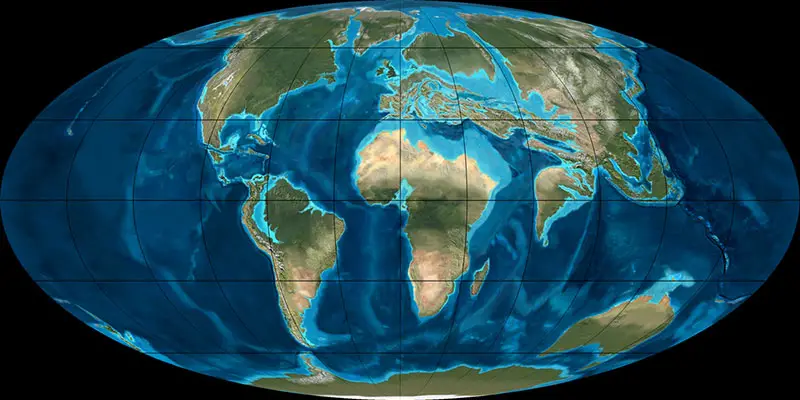†Copelemur (Notharctidae)
Copelemur ist eine Primatengattung innerhalb der Familie Notharctidae, deren 4 Mitglieder ab dem frühen Paläogen (Eozän) im Ypresium lebten, das vor ungefähr 56 Millionen Jahren begann und bis vor 47,8 Millionen Jahren andauerte. Viele Überreste wurden in Vereinigte Staaten von Amerika (USA) gefunden.
Copelemur ist der Gattungsname von drei Primatenarten, die im Eozän in Nordamerika verbreitet waren. Man stellt sie in eine eigene Unterfamilie Notharctinae innerhalb der Familie Notharctidae (Überfamilie Adapoidea innerhalb der Feuchtnasenprimaten).
Copelemur lebte zur gleichen Zeit wie Pelycodus und stammt mit an Sicherheit grenzender Wahrscheinlichkeit von diesem ab. Wegen ihrer Ähnlichkeit wurde Copelemur früher zur Gattung Pelycodus gezählt, aber Gingerich und Simons (1977) zeigten, dass sie konservativer als Pelycodus waren, da die Ausprägung des Hypoconus und Mesostyles auf den oberen Backenzähnen weniger deutlich war. Die unteren Molaren bei allen Spezies von Copelemur haben einen offenen Talonid mit einer deutlichen entoconiden Kerbe. In allen anderen Aspekten ähnelt Copelemur aber Pelycodus.
Copelemur australotutus
Das Typusexemplar mit der Bezeichnung USNM 22261 ist ein linker Unterkiefer mit Gebissfragmenten. Erhalten sind Wurzeln oder Alveoli für C-P2 sowie die Kronen von P3-M1. Der Fund stammt aus der Wasatch Formation (Typlokalität: Fossil Butte, Lincoln County, Wyoming) und ist zwischen 55,4 und 50,3 Millionen Jahre alt.
| Sammlung | Epoche, Alter | Geologie, Formation |
|---|---|---|
| Fossil Butte (Upper) | Wasatch | |
| Kommentar z. Taxonomie | ||
| said to be in the "Knight Fm." and "close below the Green River shales" (i.e., Fossil Butte Mbr.) apparently same as Fossil Butte NM west of Kemmerer; see Grande 1984 |
| Physiologie | |
|---|---|
| Gewicht: | ? |
| Schwestertaxa | |
Copelemur praetutus
Das Typusexemplar mit der Bezeichnung U.S.N.M. No. 22262 ist ein rechter Unterkieferast mit unvollständigen Prämolaren und Molaren (P3-M2). Die Funde stammen aus der Wasatch Formation (Bitter Creek, Sweetwater County, Wyoming) und sind zwischen 55,4 und 50,3 Millionen Jahre alt.
| Sammlung | Kommentar zum Fundort | Epoche, Alter | Geologie, Formation | Kommentar zur Sammlung |
|---|---|---|---|---|
| Carnivore Den | DeBeque | UCM 78020 | ||
| Kommentar z. Stratigraphie | ||||
| said to be early Wasatchian |
Copelemur tutus
Typlokalität: Almagre Arroyo (Cope, Arroyo Almagre, Gallinas Creek), Rio Arriba County, New Mexico. Die Funde stammen aus der San Jose Formation und sind zwischen 55,4 und 50,3 Millionen Jahre alt.
| Sammlung | Epoche, Alter | Geologie, Formation | Kommentar zur Sammlung |
|---|---|---|---|
| Almagre Arroyo (Cope) | San Jose | Arroyo Almagre; Gallinas Creek | |
| Kommentar z. Taxonomie | |||
| records from Simpson 1951 pertain to a list reproduced from Cope's diaries; most of Cope's collection is from the south fork of the arroyo, i.e., near AMNH Quarry 51 vicinity of multiple localities: see Lucas et al. 1981 Williamson and Lucas 1992a report Meniscotherium tapiacitum from NMMNH Loc. 241, which is on the divide between Almagre Arroyo and Arroyo Blanco possibly relevant record: Diacodon alticuspis Novacek 1982: "Ojo Almagre Quarry" "Bathmodon sulcidens" Simpson 1951: species not mentioned by Uhen and Gingerich 1995 |
Literatur
C. L. Gazin 1965, Early Eocene mammalian faunas and their environment in the vicinity of the Rock Springs Uplift, Wyoming. Wyoming Geological Association Guidebook. 19, p. 171 - 180P. D. Gingerich, E. L. Simons 1977, Systematics, phylogeny, and evolution of early Eocene Adapidae (Mammalia, Primates) in North America. Contributions from the Museum of Paleontology, University of Michigan. 24:22, p. 245 - 279
S. G. Lucas, R. M. Schoch, E. Manning 1981, The Systematics of Forstercooperia, a Middle to Late Eocene Hyracodontid (Perissodactyla: Rhinocerotoidea) from Asia and Western North America. Journal of Paleontology. 55:4, p. 826 - 841
A. J. Kihm, R. M. Schoch, E. Manning 1984, Early Eocene Mammalian Fauna of the Piceance Creek Basin. Northwestern Colorado. . :4, p. - 841
K. C. Beard, R. M. Schoch, E. Manning 1988, New notharctine primate fossils from the early Eocene of New Mexico and southern Wyoming and the phylogeny of Notharctinae. American Journal of Physical Anthropology. 75:4, p. 439 - 469
M. C. Maas, M. O'Leary, E. Manning 1996, Evolution of molar enamel microstructure in North American Notharctidae (primates). Journal of Human Evolution. 31:4, p. - 469
J. Alroy, M. O'Leary, E. Manning 2002, Synonymies and reidentifications of North American fossil mammals. . :4, p. - 469
G. F. Gunnell, J.-P. Zonneveld, W. S. Bartels 2016, Stratigraphy, mammalian paleontology, paleoecology, and age correlation of the Wasatch Formation, Fossil Butte National Monument, Wyoming\r\n. Journal of Paleontology. 90:5, p. 981 - 1011, DOI: 10.1017/jpa.2016.100
